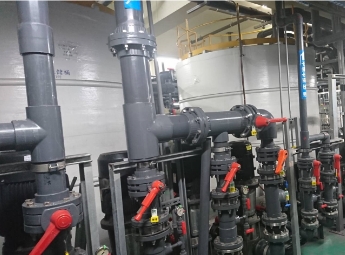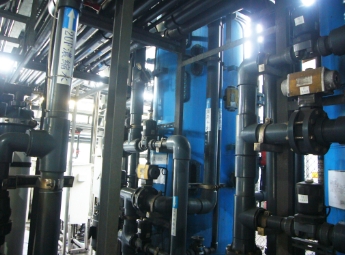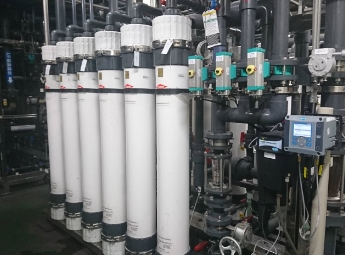Environmental Sustainability
Water Stewardship
PTI’s plants in Hukou area (P2, 3A, 3C, 3D, P9, and P10) are mainly supplied by the Shihmen Reservoir and Touqian River, while the Hsinpu Plant (P1) and HSP Plant (P8, P11A, P11B) are mainly supplied by Baoshan First and Second Reservoir. Although our facilities are not located in regions classified as water-stressed, we acknowledge that water usage can have a substantial impact on local living standards. Therefore, strict compliance with government regulations regarding water withdrawal and discharge is upheld.
To better understand and mitigate water-related risks, we utilize the Water Risk Atlas developed by the World Resources Institute (WRI) to assess water stress levels at each site. Findings indicate that all 10 operational sites are situated in regions with low to moderate water stress. In response to rapidly changing water environments driven by climate change, such as more frequent droughts and flooding, we have adopted a proactive water management approach based on three core strategies: reduction, reuse, and recycling. These strategies aim to improve water use efficiency and reinforce ongoing conservation measures across all operational sites.
Water Governance
PTI has established a comprehensive water risk identification and response framework, guided by a “top-down command and supervision, bottom-up feedback and adaptation” structure to ensure operational effectiveness in water governance. In 2024, we successfully obtained ISO 46001 certification for water efficiency management, further enhancing the effectiveness of our water resource strategies.
On an annual basis, we conduct climate-related risk and opportunity assessments in alignment with the Task Force on Climate-related Financial Disclosures (TCFD). Cross-functional committees regularly review the implementation status of key topics such as sustainability and water management, with findings reported to the Board of Directors. These governance practices continually reinforce organizational resilience in managing water-related challenges. (Please refer to the 2024 TCFD Report for details on water management in practice.)
Water Sources and Shortage Contingency Planning
In 2024, PTI sourced 98.8% of its water from municipal supplies and 1.2% from groundwater (well water), supplemented by rainwater harvesting for cleaning and irrigation purposes. Total water withdrawal reached 3,017.526 megaliters, representing an increase of 236.982 megaliters compared to 2023 due to expanded production capacity.
To proactively mitigate water shortage risks, we have developed a comprehensive emergency response plan. Through scenario simulations and situational drills, we aim to reduce potential operational disruptions. Key measures include activating on-site water storage tanks, deploying water supply tankers, and utilizing groundwater wells to ensure business continuity during periods of restricted supply.
Water Reclamation and Water Management Target
- Water Intensity: Reduced by 6% from the 2018 baseline.
- Water Recycling Rate: Maintained above 85% in dicing and grinding processes.
Process Water Conservation – Dicing/Grinding Recycling System Effectiveness
PTI is committed to recycling process wastewater at its facilities. By applying Ultra-Filtration (UF) systems with hollow fiber membranes, we effectively remove insoluble solids and steadily recycle wastewater generated from dicing and grinding operations.
For plants with dicing and grinding processes, we have installed wastewater recycling systems to enhance water resource efficiency. These systems have been implemented at the Hukou Plant (P2), Datong Plant (3A and 3C), HSP Plant 1 (P8), and HSP Plant 3 (P11B), with equipment capacity estimated based on each production line's demand. To align with production capacity planning, the recycling systems continue to be expanded and upgraded with high-reliability and easy-to-maintain key components, ensuring stable improvements in recycled water volume and equipment performance.
From 2018 to 2024, the recycling systems achieved consistent effectiveness, maintaining a recycling rate exceeding the target of 85%. In 2024, the recycling rate for the dicing and grinding process reached 86.89%. That same year, recycled water from the packaging process totaled 1,528.50 megaliters, marking a 246.138 megaliters increase (about 19.19%) compared to 2023, primarily due to adjustments in process planning.
Note 2: Ratio (%)=[recycled volume(m3) ]/ [recycled equipment intake volume(m3)]*100%
Note 3: The target water recycling system effectiveness from the dicing/grinding process in 2024 is 85%.



Wastewater Management and Compliance
All company sites comply with regulations set by competent authorities. Wastewater generated from operations is treated onsite and discharged only after meeting legally required standards for direct release or inclusion in the regulated sewer system. To ensure continuous compliance, we employ real-time monitoring systems that track key water quality indicators such as pH and conductivity, along with routine calibration of flow meters and sensors. We also undergo periodic wastewater sampling by government agencies, with all test results consistently meeting required standards. In addition, stormwater drains are regularly monitored to prevent environmental impact from potential overflow during heavy rainfall. In 2024, PTI recorded zero violations related to water resource management.
PTI Wastewater Discharge Trend
The total amount of wastewater discharged by PTI in 2024 was 2,109.579 megaliters, an increase of 141.768 megaliters compared to 2023.